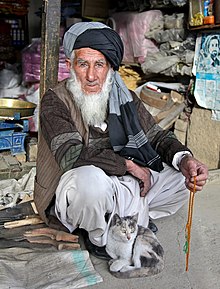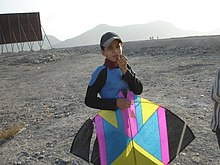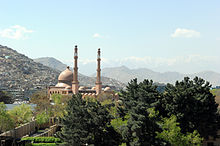Culture of Afghanistan
The culture of
Afghanistan is a mostly tribal society with different regions of the country having their own
which can be seen in the likes of language, cuisine or classical music.Afghan culture is increasingly becoming a dynamic realm of academic study in scholarly terms.
History
This section needs expansion. You can help by adding to it. (August 2023) |
Music and dance

Traditionally, only men have been involved in theater acting. Recently, in theater arts, women have begun to take center stage.[10]
Since the 1980s, the nation has witnessed several wars so music has been suppressed and recording for outsiders minimal. During the 1990s, the

Afghans enjoy music by playing many types of instruments. They also enjoy performing the
Language and literature
Poetry
Proverbs
Afghans prize wit and cleverness in speech. "Zarbul Masalha" (pronounced zar-bull mah-sal-HAA) means "proverbs" in
Naming customs and honorifics
Pet keeping

Birds are the most popular animals that are kept as pets in Afghanistan. In Kabul there is a dedicated daily market selling a wide variety of birds from around the world.[18]
Architecture

The important architectural sites are found in
. The region has made major contributions to the world'sHousing
Married sons often share houses with their parents, but with separate quarters. Afghan houses contain a special room where men socialize with each other known as a hujra. In the major cities, many Afghans live in modern houses or
-
A mud brick house on a mountainside - a common sight in the hilly areas of the Afghan countryside
-
Traditional brick homes common in the lower elevated regions in the north and west
-
Nested homes in the forest region
-
A yurt, most likely in north-eastern Afghanistan
Art, weaving, ceramics
This section needs expansion. You can help by adding to it. (August 2021) |

The lands of Afghanistan have a long history of art, with the world's earliest known usage of oil painting found in cave murals in the country.[23][24] Afghan art includes Persian miniature style, with Kamaleddin Behzad of Herat being one of the most notable miniature artists of the Timurid and early Safavid periods. Since the 1900s, the nation began to use Western techniques in art. Abdul Ghafoor Breshna was a prominent Afghan painter and sketch artist from Kabul during the 20th century.
Afghanistan's art was originally almost entirely done by men, but recently women are entering the arts programs at Kabul University. Art is largely centered at the National Museum of Afghanistan, the National Gallery of Afghanistan and the National Archives of Afghanistan in Kabul. There are a number of art schools in the country. The Center for Contemporary Arts Afghanistan (CCAA) in Kabul provides young people to learn contemporary paintings.
Ceramics and pottery, of which many tend to be turquoise-colored, are produced in Afghanistan, most famously in the village of Istalif.[25]
The art of making
Afghanistan is known for its production of Afghan rugs, traditionally handwoven using a number of well-known and highly-prized patterns.
-
Afghan items of pottery
-
Items of pottery at a shop
-
Blue glass
-
Afghan kilim
-
Afghan embroidery pattern
-
Afghan rugs and jewelry on sale, in the United States
Cuisine

Afghanistan has a wide varying landscape allowing for many different crops. Afghan cuisine is based on cereals like
- Popular Afghan dishes:
- Qabuli palao (traditional rice dish)
- Mosh Palao
- Shorba (Afghan soup)
- Do Pyaza
- Mantu (meatdumplings)
- Kofta (meatballs)
- Kichiri
- Rosh
- Chopan Kabab
- Afghani Kabab
- Mash Palao
- Qabuli Polao
- Qorma Sabzi
- Shola (sticky rice dish)
- Qoruti
- Eshkana
- Baunjan (cooked eggplant with potatoes and tomatoes)
- Bendee/Baumya (cooked okra with potatoes and tomatoes)
- Heeknusb (hummus)
- Aushak
- Aush (hand made noodles)
- Baghlava(baklava)
- crêpes)
- Chapli Kabab
- chick peaswith special toppings)
- Afghan bread)
- Popular Afghan desserts:
- Gosh Feel (pastry)
- Halwa
- Shir Berinj (rice pudding)
- Ferni
- sweet pumpkins)
- Jelabi
- Maleeda or Khajoor
- Spice Rub
Dress and attire
Afghan traditional dress typically covers the entire body with a loose top and a form of head covering. The dresses are very colorful, especially women's.[26][27]
-
Traditional tribal women's clothing
-
Traditional tribal men's clothing
-
Handmade dolls of traditional women's clothing at a fair
Sport

The sports in Afghanistan are organized by the
Football remains to be the most popular sport across Afghanistan.The
Cricket has become popular in recent years in Afghanistan. The
Religion

Islam is the main religion of Afghanistan and over 99.7%[30] of Afghans are Muslims. An estimated 84.7–90% of the population adhere to Sunni Islam, while an estimated 7–15% practice Shia Islam, and approximately 1% are followers of other religions,[30][31] most prominently Sikhism.[32] In pre-Islamic era, Zoroastrianism and Buddhism and Hinduism had a strong presence in Afghanistan; in addition, Judaism and Christianity have also had a presence in Afghanistan for over a millennia.[33][34]
Education
Since the country has one of the lowest literacy rates in the world, the United States began establishing a number of Lincoln learning centers to help with this problem and promote American culture in Afghanistan. They are set up to serve as programming platforms offering English language classes, library facilities, programming venues, Internet connectivity, educational and other counseling services. A goal of the program is to reach at least 4,000 Afghan citizens per month per location.
Higher education is provided by various
Games

Kites and "kite fighting" are highly popular in Afghanistan especially amongst children.
Holidays
Religious
Afghanistan's religious holidays are nearly the same as
Traditional
Farmer's Day, also known as
Nauruz is related to a religion called Zoroastrianism which was in practice in ancient Persia before the emergence of Islam. This festival is to celebrate the arrival of spring as plants, trees, and flowers start to bloom making the weather pleasant. On the day of Nauruz, families usually celebrate the festival by cooking food and going out for a picnic. Families cook various kinds of meals, Samanak, and Haft-mewah or dry fruits that start with the letter (س) or (S) which represents the arrival of spring season. Haft-mewah contains seven dry fruits which families place in warm water two to three days before Nauruz. Samanak is another type of dessert made from wheat and sugar. Women usually get together days before Nauruz to prepare Samanak. They pour the ingredients into a big pot placed on an open fire and take turns to stir the wheat and sugar in the pot before it turns into a thick paste. Once prepared, the dessert is then served on the day of Nauruz.[43]
National
- Afghan Independence Day (19 August 19)
- Mujahideen Victory Day (April 28)
Other
- International Women's Day (March 8)
- Remembrance Day for Martyrs and Disabled (September 9)
See also
- Bacha Bazi
- Demography of Afghanistan
- Postage stamps and postal history of Afghanistan
References
- ISBN 0-7787-9335-4. Retrieved August 22, 2010.
- ^ a b c "Article Sixteen of the Constitution of Afghanistan". 2004. Archived from the original on October 28, 2013. Retrieved June 13, 2012.
From among the languages of Pashto, Dari, Uzbeki, Turkmani, Baluchi, Pashai, Nuristani, Pamiri (alsana), Arab and other languages spoken in the country, Pashto and Dari are the official languages of the state.
- ^ "Country Profile: Afghanistan" (PDF). Library of Congress. August 2008. Archived from the original (PDF) on December 3, 2010. Retrieved August 16, 2010.
- ^ "A brief history of Afghanistan". November 2, 2008.
- ISBN 9781135189792.)
{{cite book}}: CS1 maint: multiple names: authors list (link - ^ "The remarkable rugs of war, Drill Hall Gallery". The Australian. July 30, 2021. Archived from the original on August 16, 2021.
- ^ American Institute of Afghanistan Studies. "Afghanistan (an academic journal) published by Edinburgh University Press". Archived from the original on May 25, 2020.
- JSTOR 521889.
- ^ "Redeeming the Pashtun, the ultimate warriors - Macleans.ca".
- ISSN 0882-7729. Retrieved August 15, 2021.
- ^ "It's Bollywood all the way in Afghanistan". The Hindu. Archived from the original on October 16, 2009. Retrieved March 25, 2007.
- ^ "Afghanistan Music, Traditional Instrumental Music of Afghanistan". Archived from the original on January 24, 2022. Retrieved July 22, 2011.
- ^ "Classical Dari and Pashto Poets". Archived from the original on October 6, 2013. Retrieved April 8, 2011.
- ^ Ehsan, Said (1997). "Ustad Khalilullah Khalili". Afghanmagazine.com. Archived from the original on July 9, 2010.
- ^ Kohzad, Yousef (2000). "Kharaabat". Afghanmagazine.com. Archived from the original on December 31, 2010. Retrieved April 10, 2011.
- ^ Zellem, Edward. 2012. "Zarbul Masalha: 151 Afghan Dari Proverbs". Charleston: CreateSpace.
- ^ Zellem, Edward. 2012. "Afghan Proverbs Illustrated". Charleston: CreateSpace.
- ^ "The Kabul market that sells birds from around the world". BBC News.
- ^ "SPACH: Society for the Preservation of Afghanistan's Cultural Heritage". Archived from the original on April 26, 2019. Retrieved July 31, 2020.
- ^ قسمت پنجم خانه های زیبا در جاغوری و قیمت زمین در سنگماشه. Rosta TV. January 17, 2021. Archived from the original on December 13, 2021. Retrieved February 27, 2021.
- ^ a b "Afghanistan - Political process".
- ^ Cultural Profiles Project: Afghanistan Family Life
- ^ "First-ever oil paintings found in Afghanistan". CNN. April 24, 2008. Retrieved December 3, 2012.
- ^ "World's Oldest Oil Paintings Found in Afghanistan". Fox News. April 24, 2008. Retrieved December 3, 2012.
- ^ "In Pictures: How Afghanistan's turquoise pottery sprung back to life". In Pictures: How Afghanistan's turquoise pottery sprung back to life. Retrieved January 9, 2023.
- ^ "4. Basic forms of traditional dress".
- ^ "Clothing".
- ^ "Afghan Skater Profile: Hanifa Qayoumi | Skateistan US". Archived from the original on September 11, 2013. Retrieved June 9, 2013.
- ^ "Sports". Pajhwok Afghan News. Retrieved March 30, 2011.
- ^ a b "Afghanistan". The World Factbook. www.cia.gov. Retrieved May 17, 2017.
- ^ "Chapter 1: Religious Affiliation". The World's Muslims: Unity and Diversity. Pew Research Center's Religion & Public Life Project. August 9, 2012. Retrieved September 4, 2013.
- ^ "Blood in the Abode of Peace: The attack on Kabul's Sikhs". Afghanistan Analysts Network - English (in Pashto). April 1, 2020. Retrieved January 9, 2023.
- The San Francisco Chronicle. Retrieved April 12, 2017.
- Tolo News. Retrieved February 15, 2019.
- ^ a b c "Education". United States Agency for International Development (USAID). Archived from the original on September 2, 2011. Retrieved August 11, 2011.
- ^ "Archived copy" (PDF). Archived from the original (PDF) on June 28, 2011. Retrieved June 24, 2017.
{{cite web}}: CS1 maint: archived copy as title (link) - ^ "Ghazni governor signs memorandum for Lincoln Learning Center".
- ^ "Rising literacy in Afghanistan ensures transition".
- ^ Farmer, Ben (November 30, 2011). "Sesame Street to be broadcast in Afghanistan". Kabul: The Daily Telegraph. Retrieved December 5, 2011.
- ^ DeMott, Rick (December 1, 2011). "Sesame Street To Debut In Afghanistan". AWN News. Retrieved December 5, 2011.
- ^ "Afghanistan Online: Culture - Important holidays/occasions/festivities celebrated in Afghanistan". Archived from the original on March 7, 2005. Retrieved May 24, 2005.
- ^ Lt. j.g. Keith Goodsell (March 7, 2011). "Key Afghan, US leadership plant trees for Farmer's Day". United States Central Command. Archived from the original on May 6, 2021.
- ^ "An Introduction to Afghanistan Culture" (PDF). Archived from the original (PDF) on December 15, 2017.
Further reading
- Folktale collections
- Lebedev, Konstantin [in Russian] (1972). Афганские сказки и легенды [Afghan Tales and Legends] (in Russian). Moskva: Главная редакция восточной литературы издательства Наука.
- Mills, Margaret A. Cupid and Psyche in Afghanistan: An international Tale in Cultural Context Occasional Paper (Asia Society. Afghanistan Council), No. 14, Spring/1978.
- ISBN 9780900860942.
- Dhar, Asha (1982). Folk tales of Afghanistan. New Delhi: Sterling.
- Mills, Margaret A. (2019) [1990]. Oral Narrative in Afghanistan: The Individual in Tradition. Routledge Revivals. ISBN 9781000094336.
- Ioannesyan, Youli (2009). Afghan folktales from Herat: Persian Texts in Transcription and Translation. Amherst: ISBN 978-1-60497-652-6.
- Tapper, Richard; Lindisfarne-Tapper, Nancy (2020). Afghan Village Voices: Stories from a Tribal Community. London: ISBN 978-0-7556-0085-4.
External links
- Afghanistan Cultural Profile
- Afghanistan Online: Culture
- Culture and history of Afghanistan
- Afghan's Share in Indian Art and Culture
- Afghanistan a cultural profile
- Online Afghan Calendar with Gregorian, Hejrah-e shamsi and Hejrah-e qamari dates
- National Bibliography and Publishing in Afghanistan (1871-2009)[permanent dead link]
- AfghanProverbs.com. Features Dari (Afghan Farsi) Proverbs of Afghanistan, known as "Zarbul Masalha"
- Afghanistan: Major Cultural and Historical Zones














